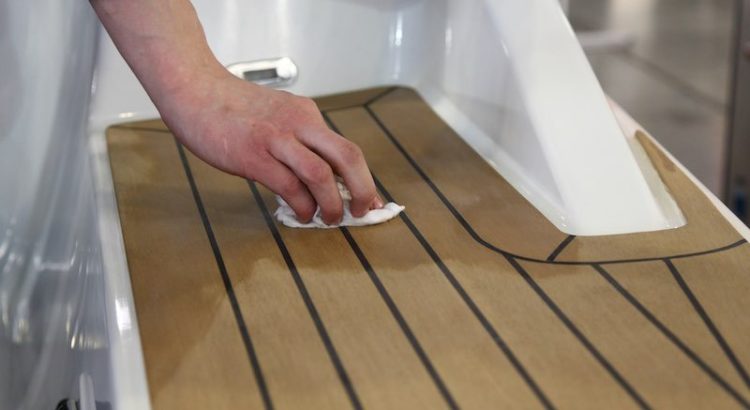This page contains affiliate links. This means that we may get a small commission for recommending products, if you choose to click on something and buy it. This does not cost you anything, but we wanted to be honest and let you know!
(Last Updated On: )Teak decking for your boat is a perfect choice as teak wood has natural properties that make it ideal for deck application.
Teak is naturally water-resistant, essential in boat decking. This excellent wood will not warp or crack when in wet environments.
Teak seems to be made specifically for boats as the wood itself does not need a sealant to protect it.
Teak produces natural oil that repels termites and other insects. The wood will not splinter over time as softer woods will.
It just keeps getting better and better with teak wood, as it requires little to no maintenance after installation.
When teak oil is applied, it will give the wood a golden hue. If left untreated, the wood will age to a silver color.

Table of Contents
What Is Teak?
A close-grained hardwood, teak has a high natural oil and rubber content. Teak is one of the hardest and strongest of all timbers.
It has a perfect combination of strength and resistance to rotting. Sun, rain, frost, and snow have little effect on teak, and the wood requires little maintenance.
If all that were not enough, teak has a high silica content, making for a non-slip surface even when wet.
These attributes have made teak popular for outdoor decking and with boat builders for centuries.
In the past, you would find teak on luxury yachts and extravagant estates.
Today, teak is a premium wood and the go-to choice for hotel designers, corporate headquarters, and upscale homes.
Teak has a beauty that translates well into furniture both indoors and out.
Teak Decking. Just for boats?
Teak is a beautiful hardwood that makes for a unique and gorgeous finish on many types of projects.
The teak used for marine decking speaks to quality and craftsmanship. Other applications for teak include outdoor patio decks and indoor flooring.
You will also find both indoor and outdoor furniture made out of teak. Patio furniture and dining room tables are popular applications for teak, too.
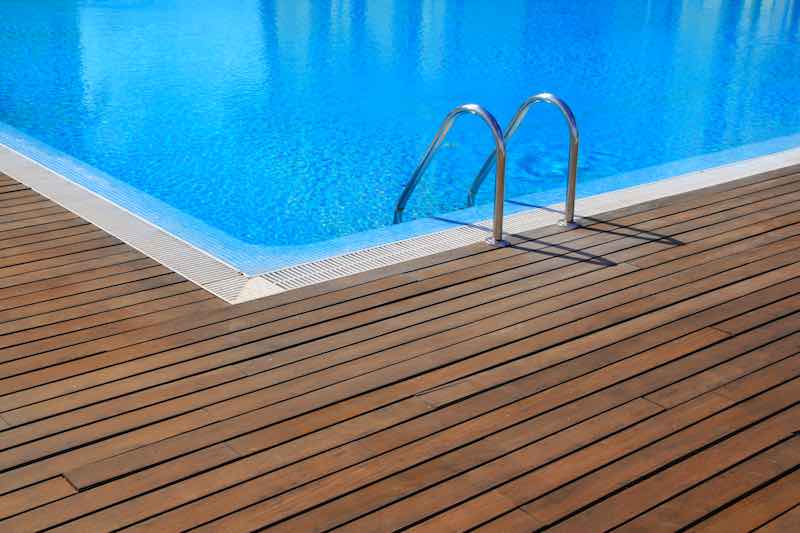
Teak Decking Benefits
Anti-slip
One critical quality for the deck of a boat, teak provides a natural anti-slip surface.
Even in times of extreme weather, teak will help you keep your sea legs. It is the high content of natural rubber that gives this advantage.
Comfort
Sailors have claimed to notice the difference between a deck with teak and one without.
Those decks with teak tended to be more comfortable to stand on for long hours.
Durable
A well cared for teak deck that is ½ thick will last between 15 and 20 years.
Insulating
Teak adds sound insulation and thermal insulation as it is a medium-density hardwood.
Repair
Light sanding will repair anything minor. If there are major repairs to be done, a marine carpenter will be able to do the repairs.
Rot Resistant
Considered to be the gold standard for decay resistance, teak is also resistant to termites.
Structure
Most teak decks that are newer are made from relatively thin wood to save weight and expense.
Even thinner teak wood will still be strong enough to add a degree of stiffness to the fore and aft loads on the structural deck.
Style
Objects made from teak, whether it be decks, furniture, or carved items, are beautiful to behold.
Decks made in geometric patterns end up looking like works of art.
Traditional
Both the yachting and boating community have boats with traditional elements. Teak decks or detailing are some of those traditional elements.
Water Resistant
Teak is one of the few kinds of wood that contains natural oil that repels water. This keeps teak from warping, cracking, or becoming brittle.
Workability
Easy to work with. However, teak does have a blunting effect on any cutting edges because of the high level of silica in the wood.
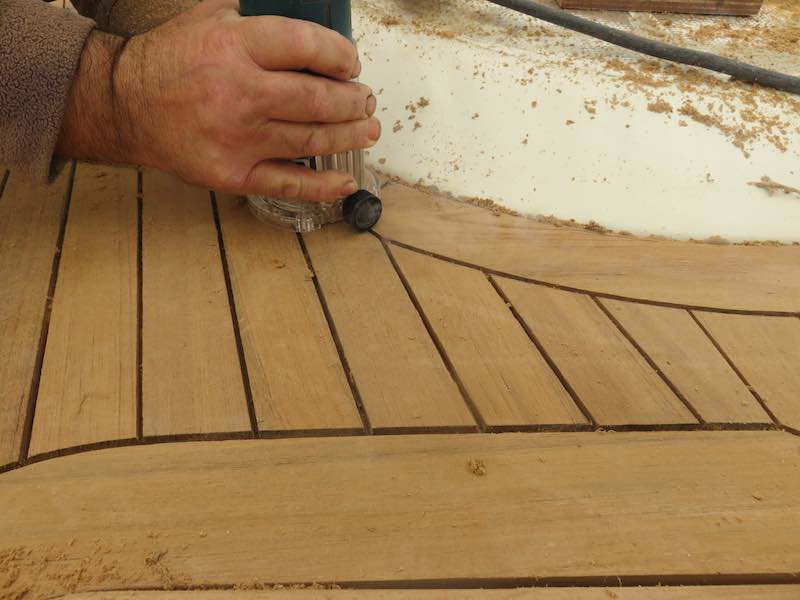
Teak Decking Styles
As was mentioned before, teak is easy to work with, although you might go through a few saw blades when cutting it.
Depending on the shape, the style employed will depend on the boat itself.
Classic
A straight, single-width layout is a traditional pattern that has stood the test of time.
Single width and same direction board lay across the entire deck.
The classic style has consistent lines that won’t compete with other design elements. The classic style provides balance and structure to your boat deck.
This pattern works well on a deck of any size. If the deck is smaller, the straight lines won’t pull the eye downward, so it gives you a sense of openness.
Classic Style With A Frame
Take that same classic style and put “picture” framing around it. Lay the main part of the deck in the classic pattern.
The “frame” would be at least one layer of deck board around the perimeter of the deck at the edge of the main inlay.
This can lend a polished look to your deck without being overly complex. It is a very traditional pattern that holds its look over time.
Pinstripe
This crisp style is a pattern that is defined by two narrow boards that are laid side by side with a standard size board.
Pinstripe is a subtle design that shows an eye for detail that is intentional. This pattern elevates the design that is reminiscent of traditional suit fabric.
It is a sophisticated style that is always fresh.
Diagonal Inlay
This style of decking is very dynamic. It is great if you have a decking area in the stern that gives room for a diagonal inlay.
Sleek lines go from left to right, and the middle of the decking holds a diagonal inlay. It makes for an interesting pattern that has depth and draws your eye to the inlay.
Herringbone
Intricate, elegant and textured, the herringbone pattern says “luxury decking.” This style is formed by repeating patterns of two deck boards meeting at 45-degree angles.
This creates a crisscrossed, interlocking design. It evokes the richness of woven textiles, much like the pinstripe does.
It is a rich visual and looks great in areas that are larger in space so that the pattern can recur.
Teak Decking Maintenance
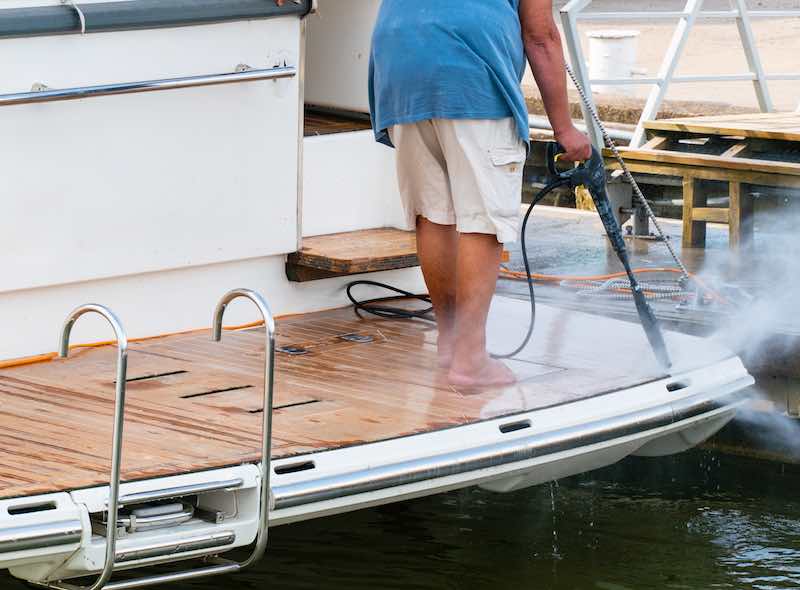
As with any other type of decking on a boat, there is maintenance to be done with teak decking.
If your boat is not in use, it helps to use one of the best boat covers.
However, if you do a regular and proper scrubbing, the teak will weather well.
Refinishing or sanding the deck would not be needed for 10 or 15 years.
Go Against The Grain
Teak is very resilient, but the wood itself consists of hardwood and softwood elements.
Unlike other woods that need to go with the grain when doing any maintenance, clean teak wood against the grain.
The reason behind this method is that the softwood elements become removed from the teak by going with the grain.
That would leave behind ridges of hardwood. In the same way, pressure washers will blast the softwood out of the teak.
Be Gentle
Pressure washing can leave ridges in the decking. This would necessitate having to sand the teak deck to level it out again.
Wash the deck regularly and stay away from stiff, hard bristle brushes. A soft brush will be kinder to the wood and is effective in getting the decking clean.
Use either fresh or salt water to clean the teak. Household cleaners will contain chemicals that can damage the surface, so avoid using those.
One or twice a year, use a specialty track deck cleaner to clean the deck, but just the fresh or saltwater in between.
While you are cleaning the deck, check the caulked seams. Look for areas that might be worn or missing caulk altogether.
If you find any, make sure to replace the caulk. This will keep moisture from getting between the deck planks.
The Color Of Teak
Teak wood turns a natural, silver/grey color. This is its natural color.
Many boaters feel that this color is the traditional way to go with teak on a boat, and others like a more freshly sanded color.
The color teak turns can also depend on the climate the boat resides in. Tropical waters will see the teak turn to the silver/grey color.
In colder climates like the Great Lakes regions, the teak will turn much darker, almost black.
Some teak on boats is actually thin trim that will turn color faster than thicker pieces of wood.
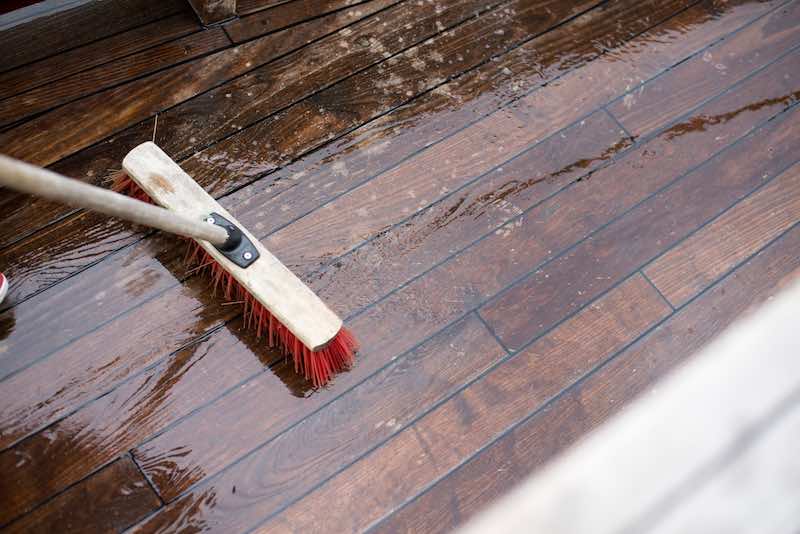
Teak Oil and Sealers
You also want to guard against the wood splitting, and so you will decide how you want to protect the wood.
Teak oils soak into the wood and replace or enhance the natural oils in the wood. There are various brands and finishes.
Some oils will have pigment added that will give the teak an appearance of having been freshly sanded.
Redo the teak oil every month or two. This can be somewhat of a hassle to have to do so frequently, so some boat owners will go with a sealer.
The sealer will seal the wood and also provide UV protection. It will last longer than teak oil.
If the color of the teak on your boat is what you want, there is a clear sealer that won’t change the wood’s color, but others that come in tinted varieties.
Sealer has the benefit of being able to withstand mildew.
If you have a mildew issue on your boat check out this article on The Best Boat Dehumidifier To Remove Humidity & Prevent Mold And Mildew
Varnish for teak decks
If you are going for a high gloss look and a hard surface, UV resistant varnish will achieve that goal.
To do so, remove the wood’s natural oil using a special cleaner, sandpaper, and acetone. Once that is done, several coats of varnish are applied.
Depending on the varnish that you choose to use, the varnish you use might be thinned for the first coat so that it seeps into the wood.
Apply varnish in layers. Each layer needs to dry thoroughly before the next layer is applied.
A light sanding is done between layers so that the next layer adheres properly.
After sanding, cleaning with a tack cloth pickles up the duct and grit from the sanding.
Depending on how rich you want the finish to look, it is typical to have as many as six or more layers.
Teak varnish will come in clear and tinted options. The finish can be satin, gloss, or matte.
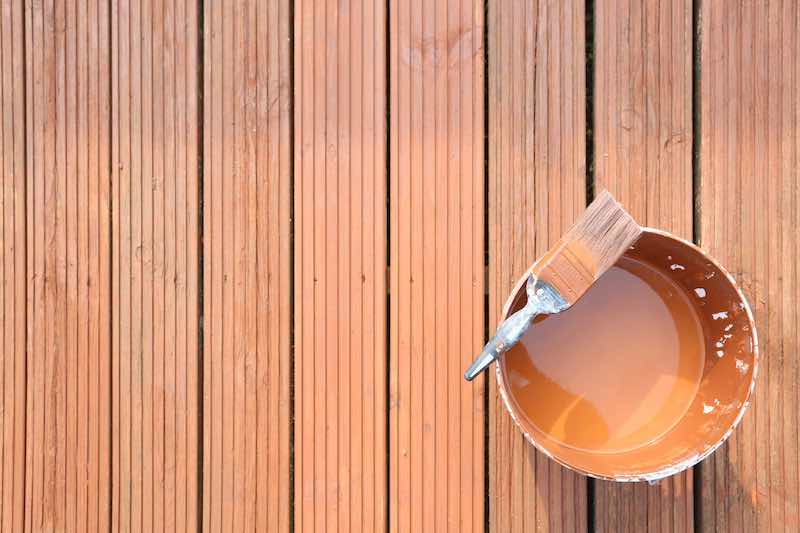
Newer Teak Decks
The beautiful scrubbed look seen on yachts and classic boats wears the deck away at up to one-tenth of an inch of thickness each year.
Although teak is a hardwood, the fibers between the grains are soft and can be damaged if not cared for properly.
If you are looking to purchase a used boat with a teak deck, know that the newer teak decks on a boat can be only about a half-inch thick.
If the deck has not been cared for correctly, it can significantly diminish the deck’s life.
Newer boats will have used adhesives to put the deck in place rather than using screws to hold the wood in place.
The adhesives mean that there is less risk of water getting in the deck’s foam or balsa core, but it also means that the teak wood used might be as little as a quarter-inch thick.
Easy Does It
To extend the life of a teak deck, scrub the teak as little as possible.
A regular wash with saltwater is all that will be needed, and after several weeks the deck will turn the natural silver/grey color.
Some may feel that they want that freshly scrubbed look, but if you are looking to purchase a used boat, the silver/grey color is what you will want to see.
Once you do clean the teak deck, use an application of teak oil to maintain the appearance.
If your teak deck needs a new lease on life and is structurally sound, you will be able to make the teak look great again.
- Sand the deck smooth
- If there are cracks, open them up with a small chisel and allow them to dry completely. Fill the gap with an epoxy-based filler.
- Pick any loose caulking out and clean the area back to bare wood. Replace the caulk.
- If the deck was installed using screws, the plugs over the screw heads could fall out. This provides a place for water to get into the structure of the deck. If this has happened, remove the screw and drill the hole to a slightly deeper level. Put the screw back in and cover it with a new, thicker teak plug and glue it in place.
- If the caulking on deck needs replacing, remove the caulk using a router that makes the groove between the planks a bit deeper than the original. This procedure gives the new caulk a sufficient depth for adhering properly.
- Sand over the deck to get rid of the excess caulk.
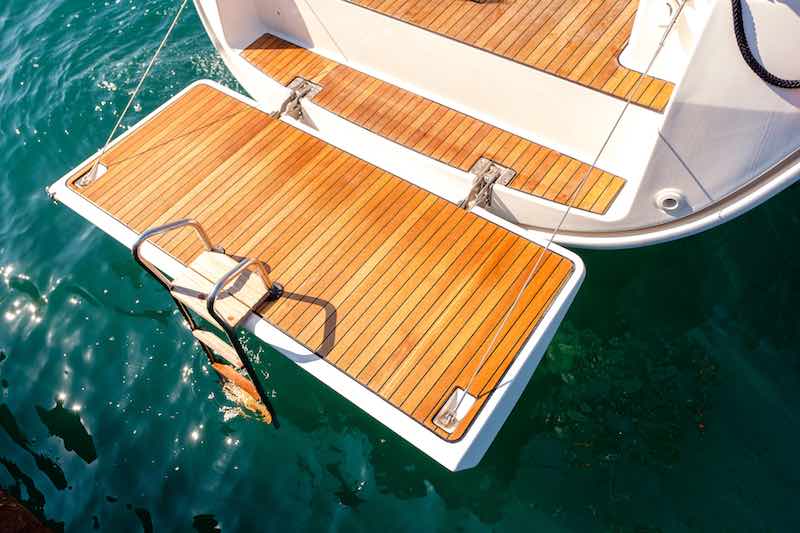
Price of Teak
Replacing or installing a teak deck on a boat is not for the faint of heart. The deck on a 40-foot boat could cost about $30,000.
If you are just looking to replace a small section of board, a one-half-inch thick piece of teak board that is one foot long will cost about $31.
On average, it would cost between $635 and $762 per square foot for teak decking.
In Conclusion
There is no doubt that teak is a beautiful wood that is well suited to marine use. It is a traditional look that has been associated with boating for centuries.
The look and feel of teak is hard to duplicate. Not only is teak a staple in the boating industry, it speaks to both luxury and traditon.
FAQ
Why is teak so expensive?
Teak is found in southeast Asian nations like Myanmar and Indonesia. Trees need to grow between 50 and 80 years to achieve the hardness needed. Before it can be cut into lumber, it must dry for two years. Governments of those nations are also not always easy to do business with.
How tall do teak trees grow?
The trees grow up to 130 feet tall and are actually part of the mint family. Their bark has often been used as a tea to soothe headaches.
